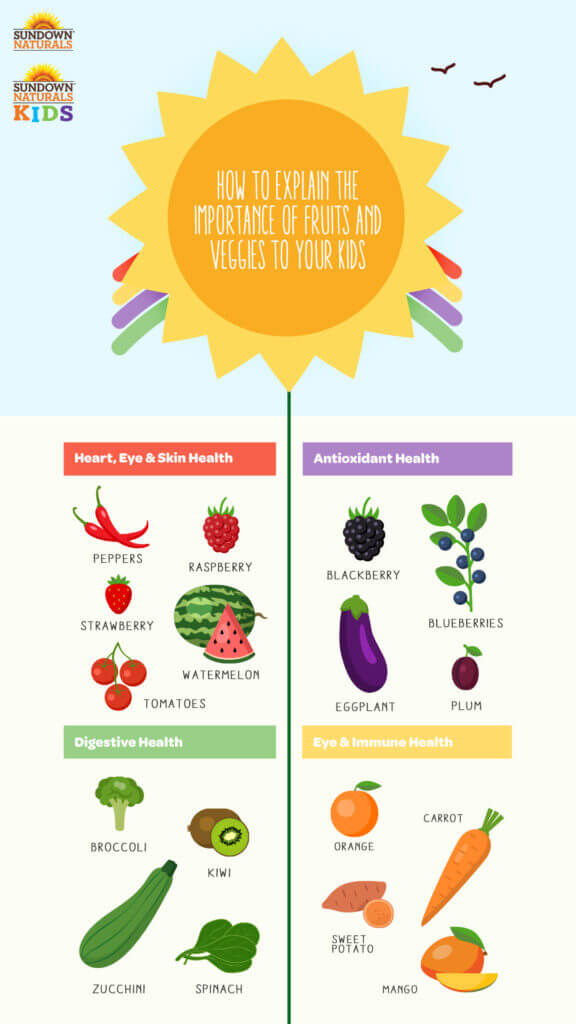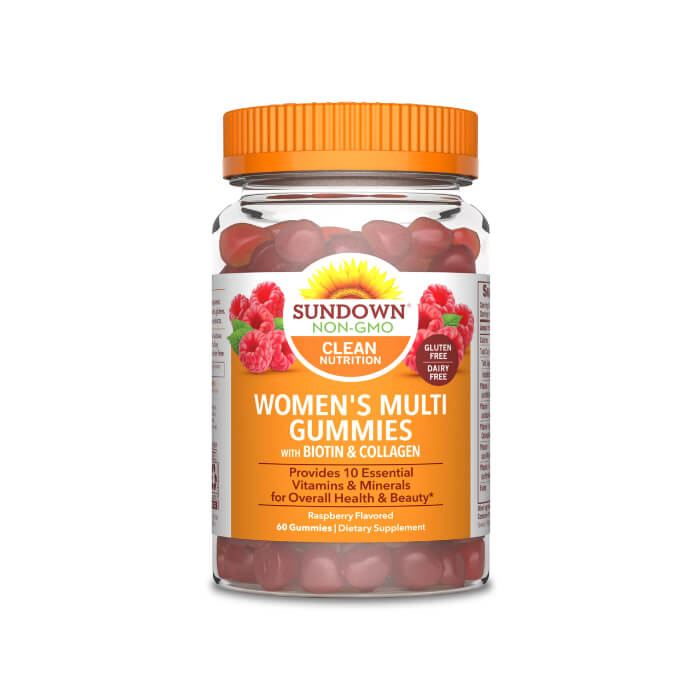How to Explain the Importance of Fruits and Veggies to Your Kids

September is “Fruits and Veggies—More Matters Month.” Explain the importance of eating fruits and veggies to your kids, and show them that they’re chock full of vitamins with our infographic below. Adults also need to consume plenty of fruits and veggies, so this can also be a helpful reminder to you, too!
How To Explain Vitamins To Your Child
As a parent, you might be wondering exactly HOW to explain what a vitamin is to your child. Start by describing how everyone needs certain vitamins every day –– and how these vitamins are found in the food we eat especially fruits and vegetables, but may not always be produced in our bodies, or sometimes not in sufficient quantities. Human beings have to get these vitamins from foods or supplements because our bodies can’t make them naturally. Vitamins help us grow and they help us stay healthy.* The key point to remember is, kids are smart! They will absorb what you tell them, and showing and explaining why fruits and vegetables are important can get kids excited about eating them. They may even start looking for these foods on their own and make a game out of it! Explain how we need to eat fruits and veggies several times each day and it’s good to get a wide variety. That’s why you may have heard that when it comes to fruits and vegetables, you should “eat the rainbow!” You can describe which vitamins are essential and WHY we need each one using this easy and colorful infographic:

How To Explain Vitamins To Your Child
RED – Peppers, Raspberries, Tomatoes, Strawberries, Watermelon Red fruits and vegetables naturally contain phytochemicals including lycopene, which is the pigment responsible for their brilliant red hue. These substances are only found in plants. These red fruits & veggies are high in vitamin C and can support heart, eye and skin health.*
ORANGE & YELLOW – Carrots, Oranges, Lemons, Mangos and Sweet Potatoes are Orange and yellow fruits and vegetables containing beneficial carotenoids, which give them their vibrant, sunny color. Orange and yellow fruits and veggies are full of fiber and contain vitamins A and C, two nutrients that are great for supporting your eyes and a healthy immune system.* Carrots, mangos and sweet potatoes in particular are high in vitamins A and C.
GREEN – Broccoli, Kiwis, Spinach and Zucchini are all Green fruits and vegetables containing a pigment called chlorophyll, which is what makes them green. Green fruits and veggies are brimming with antioxidants, phytonutrients and fiber to support digestive health. Eating something green every day can help you keep feeling your best as it contains many nutrients such as vitamins C, E, A, K and including minerals such as calcium and iron.
BLUE & PURPLE – Blueberries, Plums, Eggplant and Blackberries are Blue and Purple fruits and vegetables packed with anthocyanins and resveratrol which give these foods their rich, deep color. Blue and purple fruits and veggies provide antioxidant support, and help to support overall health and wellness.*
WHITE – Bananas, Cauliflower, Potatoes and Onions. While it may not officially be a color of the rainbow, white fruits and vegetables are also super healthy and should be a part of your everyday diet. White fruits and veggies get their color from anthoxanthins, and contain minerals such as magnesium and potassium which can help keep your bones strong and healthy.*
Show your children this infographic and talk to them. Ask them if they’ve ever wondered why carrots are orange, or why exactly white fruits and veggies are good for them. Spend some time in the produce section of the grocery store and point out all the different colors, explaining how different colors are good for different aspects of health. Show them how switching up their fruits and varying their vegetables gives them everything they need to stay healthy and feel great!
Most of all, be the example for your little ones by filling your own plate with a rainbow of fruits and veggies. Make fruits and vegetables a regular part of your snacking and serve plenty of them at family meals. When your children see others around them enjoying a variety of colorful foods on a regular basis, they’ll be more likely to readily accept this as an everyday part of life. Instilling this education early can help your child be more likely to independently choose healthy fruits and vegetables on his or her own.
And remember, it’s vital to talk about vitamins. Sundown® vitamins and supplements for adults and kids all have no gluten, no dairy, and no artificial flavors◊…only naturally sourced fruit flavors will do, particularly for our tasty gummies! Teach your kids how taking their vitamins regularly will give them the nourishment they need to grow and help them stay super healthy.*
Sources:
Products featured in this article

 July 14, 2020
July 14, 2020 5 min read
5 min read